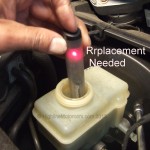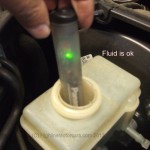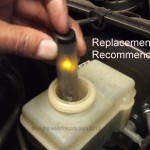Brake Fluid Flush - Is it Really Necessary?
Many car manufacturers recommend a brake fluid flush, or change, every 2 years. Why is that? Is it really necessary, or is it just a gimmick and attempt by the manufacturer to make you spend more money on unneeded service?
Let’s explore.
Brake fluid is a hydraulic fluid, either a mineral or synthetic base, designed to transfer pressure through the hydraulic brake system with minimal expansion or compression. Brake fluids are classified by the Department Of Transportation (DOT) by a number. This number represents the boiling point of the fluid.
Brake fluids have a tendency to attract moisture from the air. If you open a bottle of brake fluid, you will notice that droplets of water will accumulate on the open cap and inside the bottle neck. Moisture like this can enter the brake system, diluting the fluid and lowering its boiling point substantially.
A hydraulic brake system is not a sealed unit. The brake reservoir cap has a vent hole that allows moisture to enter as the fluid heats up during driving and cools down afterward. This moisture is a cause for concern.
Here is an example of the reduction in boiling point when the fluid is diluted with 3.7% water
Dry boiling point Diluted with 3.7% water Boiling point drop
DOT 3 401 degrees F. 284 F 117 F
DOT 4 446 degrees F. 311 F 135 F
DOT 5.1 518 degrees F. 356 F 162 F
As the table above shows, the boiling point drops substantially with moisture content. That will impact brake performance substantially.
A drop in boiling point creates a “spongy” brake pedal feel and less braking power. Water in the system can lead to corrosion in the brake lines, master cylinder, ABS blocks and calipers.
Brake fluid can also be contaminated by the wear and tear of the seals in the master cylinder and calipers. This leads to the brownish color of old fluid.
- How to Check for Brake Fluid Contamination
A brake fluid tester like the one we use at Highline European Motorcars is a sure and professional way to determine when brake fluid replacement is needed. As you can see in the pictures, there are three lights on the tester for 3 levels of contamination. Green represents up to 1.5% moisture in the system. Yellow is 1.6-2.9%, and Red is for moisture content over 3%.



Brake fluid flushing machine will be necessary to perform the job correctly. Evacuating the brake reservoir from old fluid will be the first step. A brake fluid pressure machine filled with fresh clean brake fluid will be attached to the reservoir, the technician then will open the caliper bleed screw on each caliper to remove the old fluid trapped in the system until the fluid runs clear. In some vehicles such as Mercedes models with SBC brakes, the vehicle will have to be connected to a Mercedes Star system to activate the SBC brakes during the procedure.
A regular brake fluid change/flush is essential and can provide you with consistent braking performance and extend the life of your brake system.
Gil Hovav
BMW, MERCEDES, ASE Master Technician
This article is protected under copyright laws. Property of Highline European Motorcars

